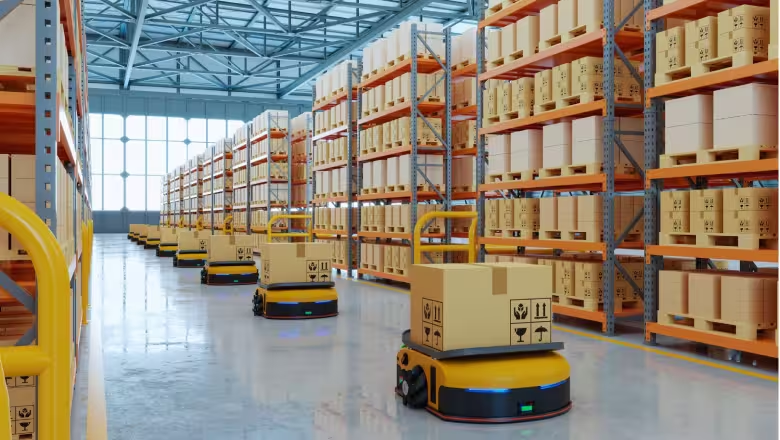도입이 처음이신가요?
ORBRO 전문가가 직접 상황을 분석하고
최적의 솔루션을 제안해드립니다.

What Is a Smart Warehouse?

In the Industry 4.0 era, warehouse management has become a decisive factor in the success of businesses within logistics and supply chains. To meet ever-growing market demands, the smart warehouse has emerged as a breakthrough solution that optimizes operational processes and enhances management efficiency. So, what exactly is a smart warehouse? Let’s explore in this article!
What Is a Smart Warehouse?
A smart warehouse is a modern storage system integrated with advanced technologies such as the Internet of Things (IoT), artificial intelligence (AI), autonomous robots, and warehouse management software (WMS). These technologies work together to automate processes like inbound receiving, outbound shipping, inventory counting, and goods tracking—delivering accuracy, speed, and efficiency far beyond traditional methods.
A smart warehouse not only stores goods but also analyzes data, forecasts demand, and optimizes storage space. It represents a major leap forward in the modernization of the logistics industry.
Key Benefits of a Smart Warehouse
Applying a smart warehouse brings tangible benefits to businesses. Below are the main advantages:
Increased Operational Efficiency: Automation reduces manual labor, saving time and boosting workforce productivity.
Cost Reduction: Optimized processes cut operating and maintenance costs while minimizing inventory-management errors.
High Accuracy: Technologies such as RFID and IoT sensors ensure precise tracking of goods, reducing loss or misplacement.
Rapid Customer Response: Advanced management systems enable fast order processing, improving customer experience and competitive edge.
Thanks to these benefits, smart warehouses have become an essential trend that no enterprise can afford to ignore.
Core Components of a Smart Warehouse
To function effectively, a smart warehouse typically includes the following components:
Warehouse Management System (WMS): The “brain” of the smart warehouse, overseeing all processes from inbound to outbound and providing analytical data to optimize operations.
Autonomous Robots: Robots handle tasks such as moving goods, palletizing, and product inspection, reducing reliance on manual labor.
IoT Sensors: Sensors monitor environmental conditions (temperature, humidity) and goods’ locations, ensuring optimal storage quality.
RFID Technology: Radio-frequency identification tags track goods in real time, enabling precise and efficient warehouse management.
The harmonious integration of these components forms an intelligent warehouse ecosystem capable of meeting the stringent demands of modern enterprises.
RTLS – Real-Time Location System in Smart Warehouses
One indispensable technology in smart warehouses is RTLS (Real-Time Location System). RTLS enables continuous, precise tracking of goods, equipment, and personnel within the warehouse, significantly enhancing management and operational effectiveness.
How RTLS Works
RTLS employs technologies such as Wi-Fi, Bluetooth, UWB (Ultra-Wideband), or RFID to determine object locations. Location tags affixed to goods, pallets, or even staff transmit signals to readers installed throughout the facility. The location data is then sent to a central management system, where it is processed and displayed to users—often as maps or visual dashboards.
Benefits of RTLS in Smart Warehouses
Precise Location Tracking: RTLS pinpoints goods’ locations to within meters, reducing search time and improving operational efficiency.
Process Optimization: By monitoring the movement of goods and personnel, RTLS helps optimize processes such as receiving, shipping, and inventory audits—speeding up order fulfillment.
Effective Inventory Management: RTLS provides real-time stock status, enabling swift, accurate decisions to avoid stockouts or overstock.
Enhanced Safety: Tracking staff and equipment locations prevents workplace accidents and ensures hazardous zones are properly monitored.
System Integration: RTLS can integrate with WMS or ERP systems, creating a comprehensive management platform that supports planning and data analysis.
Real-World Applications of RTLS
RTLS is not merely theoretical—it’s widely applied in practice. For example, in large warehouses, RTLS tracks forklift positions to ensure they follow optimal routes and avoid collisions. It also aids in managing perishable goods by monitoring both location and storage duration to maintain compliance with preservation standards.
RTLS is more than a support tool; it’s a critical factor that enables seamless, efficient smart warehouse operations and delivers a competitive advantage to businesses.
Conclusion
A smart warehouse is not just a technology solution—it’s the key to optimizing warehouse management, reducing costs, and strengthening competitiveness. Supported by technologies like RTLS, smart warehouses deliver outstanding performance to meet the demands of modern logistics. As the industry continues to evolve, adopting smart warehouse solutions is a strategic move every business should consider.
Are you ready to elevate your company to the next level with a smart warehouse? Contact us today for detailed consultation and to discover the best solutions for your needs!
공유하기






